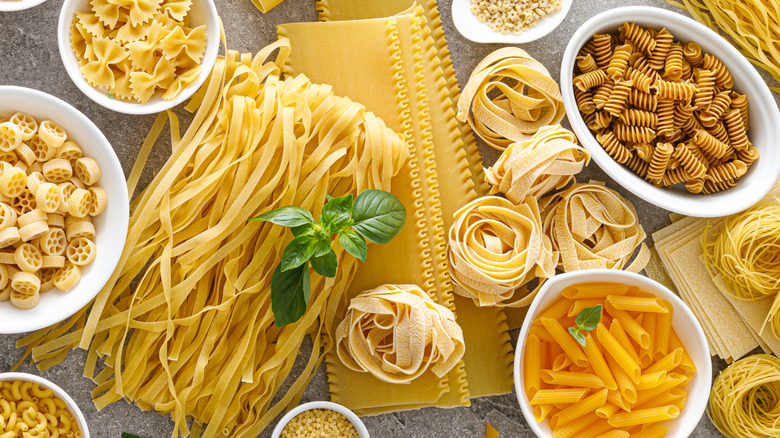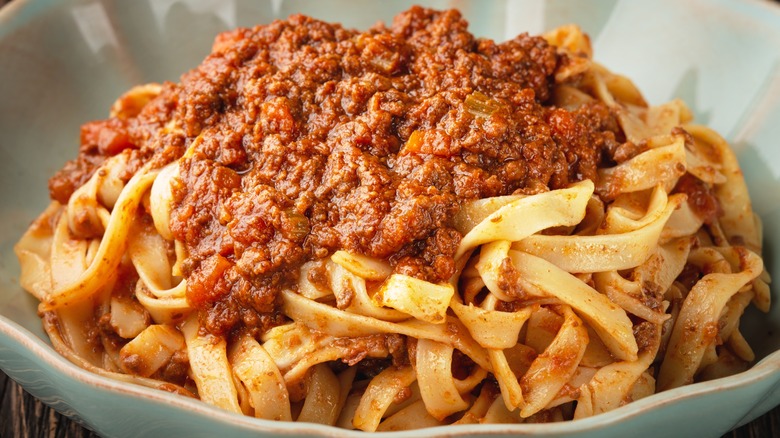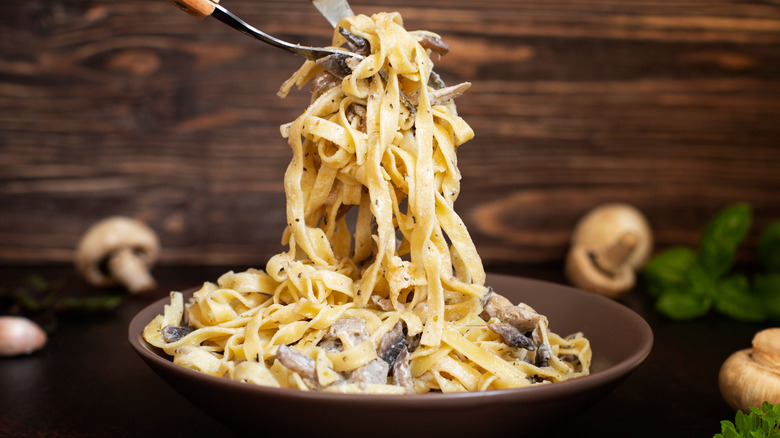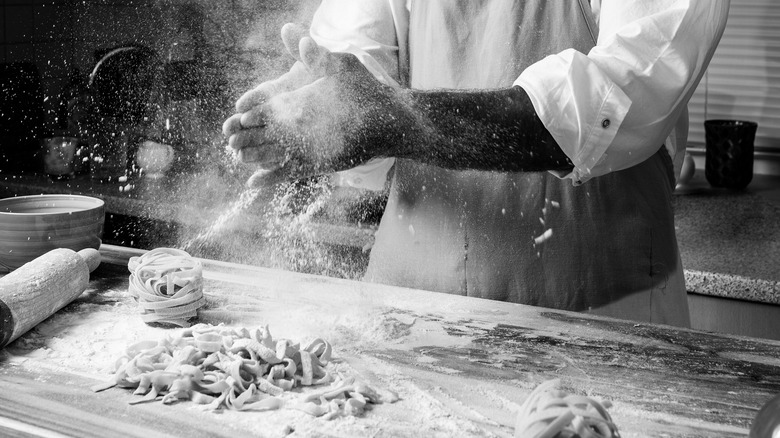Tagliatelle Vs. Fettuccine: What's The Difference?
There is an absolutely excellent video from Bon Appétit on YouTube showing Luca D'Onofrio, the Pastaio of Eataly Flatiron, making 29 different shapes of handmade pasta using egg, squid ink, spinach, and semolina dough. Twenty-nine different pasta shapes may seem like a lot, and trust us, it is. There's a good chance that most of us weren't even aware that 29 different types of pasta even existed. So, your amazement would be forgiven upon discovering that Italy has over 400 different pasta shapes, some of which have different names and variations (via Eataly).
Of course, every region of Italy has its own favorite pasta dishes, as Italian Foodies lists. Calabria has the fileja pasta. Campania has spaghetti's alla vongole and puttanesca. Emilia-Romagna has tagliatelle, and Tuscany and Lazio have fettuccine. We'll pause on the last two because there tends to be some confusion as to whether or not they are actually different. It's easy to be confused when Italy has hundreds of different pasta shapes, but there are substantial differences between tagliatelle and fettuccine that should be expounded upon.
Tagliatelle: the pride of Bologna
In the city of Bologna, there is no pasta quite as prized as tagliatelle. It is the perfect pasta to pair with the city's rich ragù bolognese meat sauce that has become iconic the world over. In Bologna, the task of making this popular pasta falls to the "razdore," or pasta ladies. The dough of the tagliatelle is made of semolina flour and egg. The pasta ladies will then roll out the dough by hand, fold the rolled-out sheets, and cut them into long, flat strands of pasta (via La Cucina Italiana and The Spruce Eats).
Despite being indicative of Emilia-Romagna, of which Bologna is the capital, tagliatelle can be found in the next-door region of Marche, which has its own version of ragù that uses duck, rabbit, or pork instead of beef, per Italian Foodies. There are many other pairings, apart from ragù, that favor tagliatelle. Among them is tagliatelle with a simple sauce of tomatoes and basil, tagliatelle with cream and salmon, and tagliatelle with cream, onions, prosciutto, and olive oil, per The Spruce Eats. There is another combination, according to MasterClass, called uovo e formaggio (eggs and cheese), which is similar to carbonara, but without the addition of the meat.
Fettuccine: a staple of Rome and Tuscany
As you travel farther south along the Italian peninsula, you'll notice something interesting about the nature of the pasta. Northern regions, like Emilia-Romagna or Marche, use eggs when making their pasta dough. However, once you hit Tuscany, which is directly south of Emilia-Romagna, the eggs start to ebb away until they all but vanish by the time you hit Campania, per Italy Magazine. This lack of eggs is typically indicative of our next pasta, fettuccine. A staple of Tuscany and Lazio, home to Rome, the lack of eggs in fettuccine means that it has a longer shelf life and is easier to dry, which is why you are very likely to find it in grocery stores around the world (via The Spruce Eats).
Like tagliatelle, fettuccine is a long, flat pasta. Meaning "little ribbons" in Italian, fettuccine has its own iconic sauce pairing in Alfredo, which is a creamy sauce of Roman descent. On the Tuscan front, according to MasterClass, fettuccine is used as an easy weeknight meal when combined with meat, vegetables, and olive oil. Overall, when judging from a distance, you would be hard-pressed to find any noticeable differences between fettuccine and tagliatelle. However, if you've got a metric ruler, you'll discover that the difference between the two really is down to the millimeter.
Differences and substitution
Now that you have your metric ruler take a single ribbon of fettuccine and a single ribbon of tagliatelle, place them side-by-side, and measure the width of each. You'll find that the tagliatelle is slightly wider than the fettuccine. Seven millimeters raw to eight millimeters cooked, to be exact, per La Cucina Italiana. You'll also like notice in this side-by-side comparison that the tagliatelle is rolled out slightly thinner than the fettuccine, which is typically about a quarter inch thick, according to MasterClass.
Unless you're an absolute purist who believes that pastas cannot be exchanged for one another, you're likely going to concede that you can use fettuccine and tagliatelle interchangeably, as MasterClass explains. Either will pair well with any of the sauces we've mentioned, owing to the fact that both tagliatelle and fettuccine belong to the family of long pastas. This family includes the likes of spaghetti, linguine, and pappardelle. What it boils down to in the end is a matter of preference and tradition. There is nothing wrong with eating tagliatelle Alfredo or fettuccine bolognese. But, if you like to keep with tradition, there's nothing wrong with that either.



